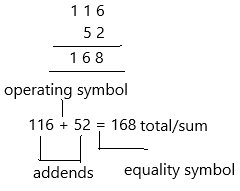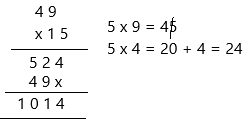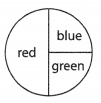By accessing our 180 Days of Math for Fifth Grade Answers Key Day 155 regularly, students can get better problem-solving skills.
180 Days of Math for Fifth Grade Answers Key Day 155
Directions: Solve each problem.
Question 1.
116 + 52 = ___________
Answer:
The addition is the term used to describe adding two or more numbers together. The addition is denoted using the plus sign ‘+‘ such as the addition of 3 and 3 can be written as 4 + 4. Also, the plus sign (+) can be used as many times as required, such as
4 + 4 + 4 + 4.

Therefore, the answer is 168
Question 2.
49 × 15 = _________
Answer:
In mathematics, multiplication is a method of finding the product of two or more numbers. It is one of the basic arithmetic operations, that we use in everyday life. The major application we can see in multiplication tables.
In arithmetic, the multiplication of two numbers represents the repeated addition of one number with respect to another. These numbers can be whole numbers, natural numbers, integers, fractions, etc. If m is multiplied by n, then it means either m is added to itself ‘n’ a number of times or vice versa.
The formula for multiplication:
The multiplication formula is given by:
Multiplier × Multiplicand = Product
– The multiplicand is the total number of objects in each group
– A multiplier is the number of equal groups
– Product is the result of multiplication of multiplier and multiplicand

Therefore, the answer is 1014.
Question 3.
![]()
Answer:
The square root of a number is defined as the value, which gives the number when it is multiplied by itself. The radical symbol √ is used to indicate the square root. For example, √9 = 3. The radical symbol is also called a root symbol or surds. If a number is a perfect square, we can easily find the square root of the number. If the given number is not a perfect square number, the square root can be found using the long division method.
–therefore, the square root of 273 is 16.566
The above-given question is 17 square root of 273 is:
Now multiply 17 by 16.566
Thus, 17*16.566 is 281.622
Question 4.
Is 57,201 less than 57,102?
Answer:
There are certain rules, based on which it becomes easier to compare numbers. These rules are:
– Numbers with more digits: When we compare numbers, then check if both the numbers are having the same number of digits or not. If a number has more digits, then it is greater than the other number.
– Numbers starting with a larger digit: This rule is applicable when two numbers are having the same number of digits. In such cases, we need to check the digit at the leftmost place, whichever is greater. Therefore, the number with a greater digit at the leftmost place of the number is greater than the other number.
The above-given numbers are: 57,201 and 57,102
– both the numbers have an equal number of digits, therefore, we will compare the left-most digit of both numbers.
– As we can see the first two digits are the same for both the numbers, thus we need to compare the next left-most digit of both numbers.
– 2 > 1
Therefore, 57,201 > 57,102
Hence, 57,201 is greater than 57,102
Question 5.
\(\frac{2}{10}\) + \(\frac{2}{10}\) = ___________
Answer:
\(\frac{2}{10}\) can be written as 2/10
\(\frac{2}{10}\) can be written as 2/10
2/10 + 2/10
= 2 + 2/10
= 4/10
= 2/5
therefore, the value of above-given latex equation is 2/5
Question 6.
Write the number that comes next in the sequence.
45, 135, 225, _____
Answer: 315
number patterns are the patterns in which a list number that follows a certain sequence.
In the given pattern, the sequence is increased by 90. It means the addition of the number 90 to the next number then it will be 135. And add 90 to the 135.
90 + 135 = 225
225 + 90 = 315
Therefore, the sequence is 45, 135, 225, 315.
Question 7.
8 × 6 = ![]() – 40
– 40
Answer:
Let the empty box be T
8 × 6 = T – 40
48 = T – 40
Now get 40 to the left-hand side then the equation is:
48 + 40 = T
88 = T
Now substitute the T value in the above equation.
48 = T – 40
48 = 88 – 40
48 = 48
LHS = RHS
Hence, the answer is verified.
Question 8.
2 yards = ________ inches
Answer:
1 yard is equal to 3 inches:
1yd = 36in
The distance d in inches (in) is equal to the distance d in yards (yd) times 36:
d(in) = d(yd) × 36
d (inches) = 2 × 36
d (inches) = 72
Question 9.
True or false?
All rectangles are squares.
Answer: False
In a square all sides are equal, but in a rectangle length and breadth are different. All squares are rectangles but all rectangles are not square.
Question 10.
Fish Caught
|
Juan |
Maggi | Max | Erik | Aliki | Tia |
Jarome |
| 7 | 4 | 5 | 7 | 11 | 4 | 7 |
One fish can feed two people. How many people can Aliki feed with the fish she caught?
Answer:
The number of people who can be fed by one fish = 2
The number of fishes Aliki caught = 11
The number of people can Aliki feed with the fish she caught = F
F = 11 x 2
F = 22
Therefore, 22 people can Aliki feed with the fish she caught.
Question 11.
Using the spinner below, what is the probability that you will land on red or green?

Answer:
The spinner is divided into three sections.
The total spinner is 100%
Half of the section is red which means 50%
P(red) = 50/100=1/2
and the remaining are blue and green
P(green)=25/100=1/4.
Therefore, the probability that landing on a red or green
P(red or green) = 1/2 + 1/4
P(red or green) = 2+1/4
P(red or green) = 3/4
Question 12.
In magic squares, each row, column, and diagonal adds up to the same number. Complete the magic square using each number 4-12 only once.

Answer:
– Now, we must calculate the _magic constant_. To calculate the magic constant, add all nine numbers used in the magic square and divide by the number of rows. In the above-given, add 4+5+6+7+8+9+10+11+12=72, then divide by 3.
– The magic constant for this problem is 24, as 72 / 3 = 24.
– Add the unused numbers to the open boxes in the magic square so that the rows, columns, and diagonals add up to 24.
– In the first row: 7 + 5 = 12, the missing number to total 24 is 12.
– In the second column: 12 + 8 = 20, the missing number to total 24 is 4.
– In the first column: 7+11 = 18, the missing number to total 24 is 6.
– In the third row: 9 + 4 = 13, the missing number to total 24 is 11.
– In the third column: 5 + 9 = 14, the missing number to total 24 is 10.
– Now, we can double-check the columns, rows, and diagonals to verify that we have indeed solved the magic square.
